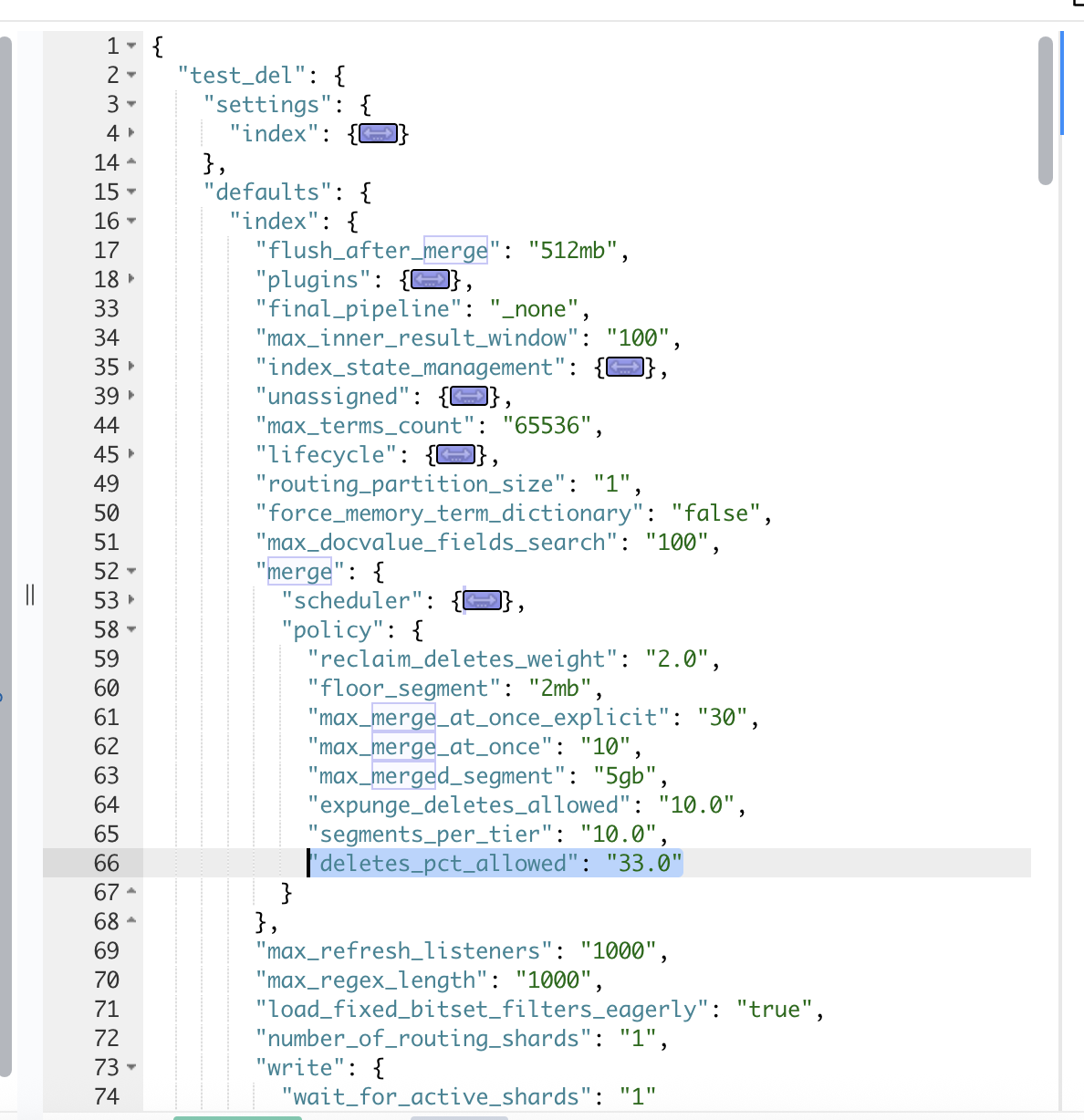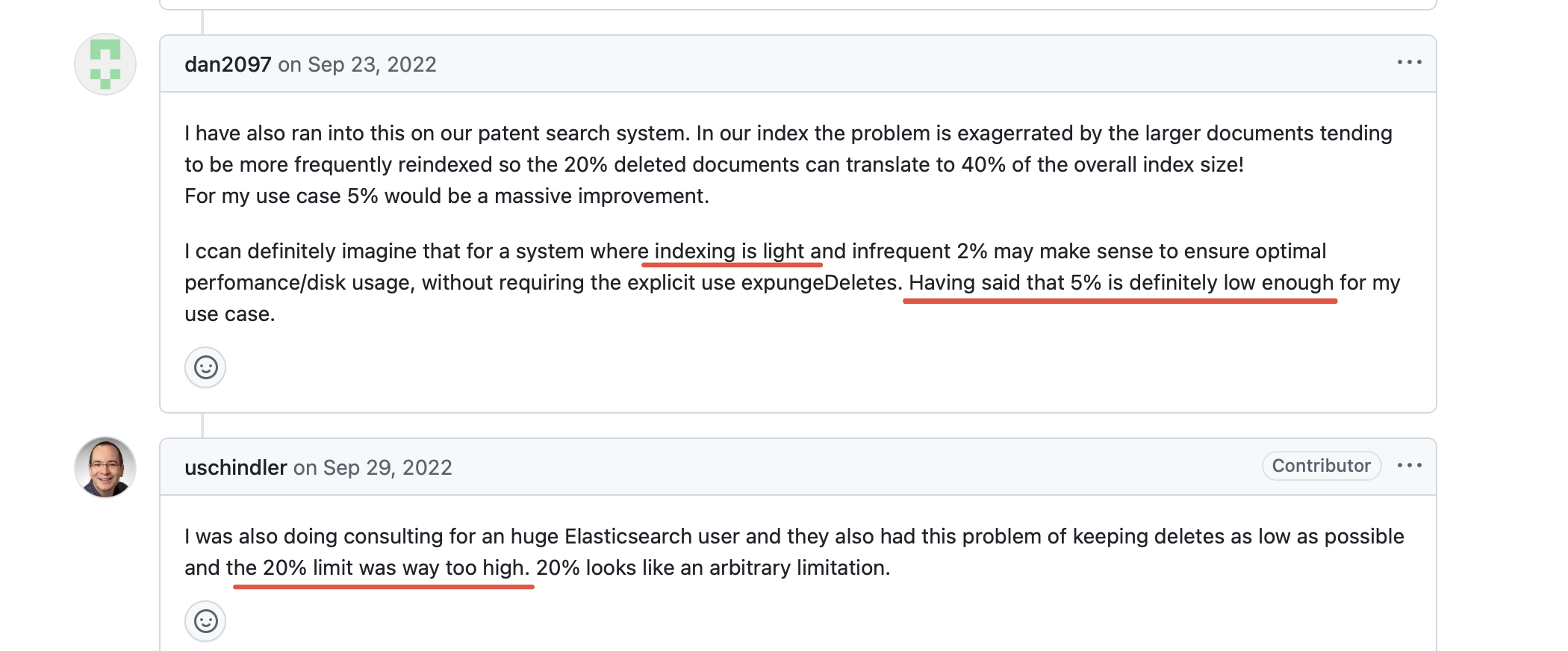最近发现了 lucene 9.5 版本把 merge 策略的默认参数改了。
* GITHUB#11761: TieredMergePolicy now allowed a maximum allowable deletes percentage of down to 5%, and the default
maximum allowable deletes percentage is changed from 33% to 20%. (Marc D'Mello)
也就是 index.merge.policy.deletePctAllowed 最小值可以取 5%(原来是 20%),而默认值为 20%(原来是 33%)。
这是一个控制索引中已删除文档的占比的参数,简单来说,调低这个参数能够降低存储大小,同时也需要更多的 cpu 和内存资源来完成这个调优。
通过这个 帖子的讨论,大家可以发现,“实践出真知”,这次的参数调整是 lucene 社区对于用户积极反馈的采纳。因此,对于老版本的用户,也可以在 deletepct 比较高的场景下,调优这个参数,当然一切生产调整都需要经过测试。
对于 ES 的新用户来说,这时候可能冒出了下面这些问题
- 这个参数反馈的已删除文档占比 deletepct 是什么?
- 它怎么计算的呢?较高的 deletepct 会有什么影响?
- 较低的 deletepct 为什么会有更多的资源消耗?
- 除了调优这个参数还有什么优化办法么?
伴随这些问题,来探讨一下这个参数的来源和作用。
deletePctAllowed:软删除的遗留 #
在 Lucene 中,软删除是一种标记文档以便后续逻辑删除的机制,而不是立即从索引中物理删除文档。
但是这些软删除文档又不是永久存在的,deletePctAllowed 表示索引中允许存在的软删除文档占总文档数的最大百分比。
当软删除文档的比例达到或超过 deletePctAllowed 所设定的阈值时,Lucene 会触发索引合并操作。这是因为在合并过程中,那些被软删除的文档会被物理地从索引中移除,从而减少索引的存储空间占用。
当 deletePctAllowed 设置过低时,会频繁触发索引合并,因合并操作需大量磁盘 I/O、CPU 和内存资源,会使写入性能显著下降,磁盘 I/O 压力增大。假设 deletePctAllowed 为 0,则每次写入都需要消耗额外的资源来做 segment 的合并。
deletePctAllowed 过高,索引会容纳大量软删除文档,占用过多磁盘空间,增加存储成本且可能导致磁盘空间不足。查询时要过滤大量软删除文档,使查询响应时间变长、性能下降。同时也观察到,在使用 soft-deleted 特性后,文档更新和 refresh 也会受到影响,deletePctAllowed 过高,文档更新/refresh 操作耗时也会明显上升。
deletePctAllowed 的实际效果 #
从上面的解释看,index.merge.policy.deletePctAllowed 这个参数仿佛并不难理解,但实际上这个参数是应用到各个 segment 级别的,并且 segment 对这个参数的触发条件也是有限制(过小的 segment 并不会因为这个参数触发合并操作)。在多分片多 segment 的条件下,索引对 deletePctAllowed 参数实际的应用效果并不完全一致。因此,可以做个实际测试来看 deletePctAllowed 对索引产生的效果。
这里创建一个一千万文档的索引,然后全量更新一遍,看最后 deletePctAllowed 会保留多少的被删除文档。
GET test_del/_count
{
"count": 10000000,
"_shards": {
"total": 1,
"successful": 1,
"skipped": 0,
"failed": 0
}
}
# 查看 delete 文档数量
GET test_del/_stats
···
"primaries": {
"docs": {
"count": 10000000,
"deleted": 0
},
···
这里的 deletePctAllowed 还是使用的 33%。

更新任务命令:
POST test_del/_update_by_query?wait_for_completion=false
{
"query": {
"match_all": {}
},
"script": {
"source": "ctx._source.field_name = 'new_value'",
"lang": "painless"
}
}
完成后,
# 任务状态
···
"task": {
"node": "28HymM3xTESGMPRD3LvtCg",
"id": 10385666,
"type": "transport",
"action": "indices:data/write/update/byquery",
"status": {
"total": 10000000,
"updated": 10000000,# 这里可以看到全量更新
"created": 0,
"deleted": 0,
"batches": 10000,
"version_conflicts": 0,
"noops": 0,
"retries": {
"bulk": 0,
"search": 0
},
"throttled_millis": 0,
"requests_per_second": -1,
"throttled_until_millis": 0
}
···
# 索引的状态
GET test_del/_stats
···
"_all": {
"primaries": {
"docs": {
"count": 10000000,
"deleted": 809782
},
···
实际删除文档与非删除文档的比例为 8.09%。
现在尝试调低 index.merge.policy.deletes_pct_allowed到 20%。
PUT test_del/_settings
{"index.merge.policy.deletes_pct_allowed":20}
由于之前删除文档占比过低,调整参数并不会触发新的 merge,因此需要重新全量更新数据查看一下是否有改变。
最终得到的索引状态如下:
GET test_del/_stats
···
"primaries": {
"docs": {
"count": 10000000,
"deleted": 190458
}
···
这次得到的实际删除文档与非删除文档的比例为 1.9%
deletes_pct_allowed 默认值的调整 #
上面提到 deletePctAllowed 设置过低时,会频繁触发索引合并,而合并任务的线程使用线程类型是 SCALING 的,是一种动态扩展使用 cpu 的策略。

那么,当 deletePctAllowed 设置过低时,merge 任务增加,cpu 线程使用增加。集群的 cpu 和磁盘的使用会随着写入增加,deletePctAllowed 降低产生了放大效果。
所以,在没有大量数据支撑的条件下,ES 的使用者们往往会选择业务低峰期使用 forcemerge 来降低文档删除比,因为 forcemerge 的线程类型是 fixed,并且为 1,对 cpu 和磁盘的压力更加可控,同时 forcemerge 的 deletePctAllowed 默认阈值是 10%,更加低。
而社区中,大家的实际反馈则更倾向使用较低的 deletePctAllowed 阈值,特别是小索引小写入的情况下。

并且提供了相应的 测试结果
#### RUN 1
Test config:
Single node domain
Instance type: EC2 m5.4xlarge
Updates: 50% of the total request
Baseline:
OS_2.3
"index.merge.policy.deletes_pct_allowed" : "33.0"
Target:
OS_2.3
"index.merge.policy.deletes_pct_allowed" : "20.0"
| Metrics | Baseline | Target |
------------------------------------
| Store size | 39gb | 37gb |
| Deleted docs percent | 22% | 18% |
| Avg. CPU | (42 - 53)% | (43 - 55)% |
| Write throughput | 11 - 15 mbps | 11 - 17 mbps |
| Indexing latency | 0.15 - 0.36 ms | 0.15 - 0.39 ms |
| P90 search latency | 14.9 ms | 13.2 ms |
| P90 term query latency | 13.7 ms | 13.5 ms |
#### RUN 2
Test config:
Single node domain
Instance type: EC2 m5.4xlarge
Updates: 75% of the total request
Baseline:
OS_2.3
"index.merge.policy.deletes_pct_allowed" : "33.0"
Target:
OS_2.3
"index.merge.policy.deletes_pct_allowed" : "20.0"
| Metrics | Baseline | Target |
------------------------------------
| Store size | 19.4gb | 17.7gb |
| Deleted docs percent | 22.8% | 15% |
| Avg. CPU | (43 - 53)% | (46 - 53)% |
| Write throughput | 9 - 14.5 mbps | 10 - 15.9 mbps |
| Indexing latency | 0.14 - 0.33 ms | 0.14 - 0.28 ms |
| P90 search latency | 15.9 ms | 13.5 ms |
| P90 term query latency | 15.7 ms | 13.9 ms |
#### RUN 3
Test config:
Single node domain
Instance type: EC2 m5.4xlarge
Updates: 80% of the total request
Baseline:
OS_2.3
"index.merge.policy.deletes_pct_allowed" : "33.0"
Target:
OS_2.3
"index.merge.policy.deletes_pct_allowed" : "20.0"
| Metrics | Baseline | Target |
------------------------------------
| Store size | 15.9gb | 14.6gb |
| Deleted docs percent | 24% | 18% |
| Avg. CPU | (46 - 52)% | (47 - 52)% |
| Write throughput | 9 - 13 mbps | 10 - 15 mbps |
| Indexing latency | 0.14 - 0.28 ms | 0.13 - 0.26 ms |
| P90 search latency | 15.3 ms | 13.6 ms |
| P90 term query latency | 15.2 ms | 13.4 ms |
#### RUN 4
Test config:
Single node domain
Instance type: EC2 m5.2xlarge
Updates: 80% of the total request
Baseline:
OS_2.3
"index.merge.policy.deletes_pct_allowed" : "33.0"
Target:
OS_2.3
"index.merge.policy.deletes_pct_allowed" : "20.0"
| Metrics | Baseline | Target |
------------------------------------
| Store size | 21.6gb | 17.8gb |
| Deleted docs percent | 30% | 18% |
| Avg. CPU | (71 - 89)% | (83 - 90)% |
| Write throughput | 6 - 12 mbps | 10 - 15 mbps |
| indexing latency | 0.21 - 0.30 ms | 0.20 - 0.31 ms |
| P90 search latency | 15.4 ms | 16.3 ms |
| P90 term query latency | 15.4 ms | 14.8 ms |
在测试中给出的结论是:
- CPU 和 IO 吞吐量没有明显增加。
- 由于索引中删除的文档数量较少,搜索延迟更少。
- 减少被删除文档占用的磁盘空间浪费
但是也需要注意,这里的测试索引和消耗资源并不大,有些业务量较大的索引还是需要重新做相关压力测试。
另一种调优思路 #
那除了降低 deletePctAllowed 和使用 forcemerge,还有其他方法么?
这里一个 pr,提供一个综合性的解决方案,作者把两个 merge 策略进行了合并,在主动合并的间隙添加 forcemerge 检测方法,遇到可执行的时间段(资源使用率低),主动发起对单个 segment 的 forcemerge,这里 segment 得删选大小更加低,这样对 forcemerge 的任务耗时也更低,最终减少索引的删除文档占比。
简单的理解就是,利用了集群资源的“碎片时间”去完成主动的 forcemerge。也是一种可控且优质的调优方式。








 400-139-9200
400-139-9200











